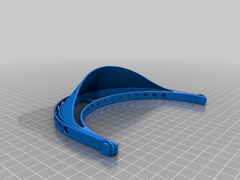
Face shield mask for smaller 3D printers –
I designed this mask for smaller printers than the usual 20cm x 20cm hot bed. The smaller side of the hot bed must be 13cm or higher; and the other side must be 17cm or higher.
Like the original ones, this model does not need to use another strap to hold it, nor pierce the acetate to hold it neither. It needs only an A4 acetate and must be placed in the groove on the front of the mask. However special care must be taken with the temperature, flow and level configuration in order to avoid the merge of the groove. Brim or raft is prohibited.
Warning: although the original model was designed and approved for use within medical facilities in exposure to COVID-19 patients, the model posted here was never tested for this use, so it could be used for public attention but it must not be used as first barrier against these patients.
Español
Este post es una modificación de una máscara en la que estuve trabajando con un equipo de mi universidad, con el objetivo de proveer de insumos impresos en 3D, estudiados, testeados and rediseñandos a centros médicos acá en Argentina, en esta emegencia sanitaria por el virus COVID-19. El modelo publicado por mi universidad es una modificación de éste modelo de HanochH.
Diseñé este modelo para ser impresos en impresoras más chicas que la impresora promedio de 20cm x 20cm. El lado más corto de la cama debe ser de 13cm o más; mientras que el otro lado debe ser 17cm o más.
Como los modelos originales, éste no requiere de una cinta para agarrarse a la cabeza, así como tampoco agujerear el acetato para sostenerlo. Lo único que necesita es un acetato en formato A4 que se introduce en la rendija del frente. Sin embargo se debe tener especial cuidado con las configuraciones de temperatura, flujo y nivelación para evitar que los lados de la rendija se fundan entre sí. Se debe evitar usar brim o raft.
Atención: aunque el modelo original fue diseñado y aprobado para su uso en centros médicos con exposición a pacientes con COVID-19, el modelo publicado en este post nunca fue testeado para este uso, por lo que puede usarse en atención al público pero no debe usarse como primera barrera contra éstos pacientes.

This information appeared first at https://www.thingiverse.com/thing:4264881






More Stories
Daily Wire August 28, 2020 at 10:45AM
Latest Articles August 28, 2020 at 10:45AM
Pamela Geller, Atlas Shrugs August 28, 2020 at 10:45AM